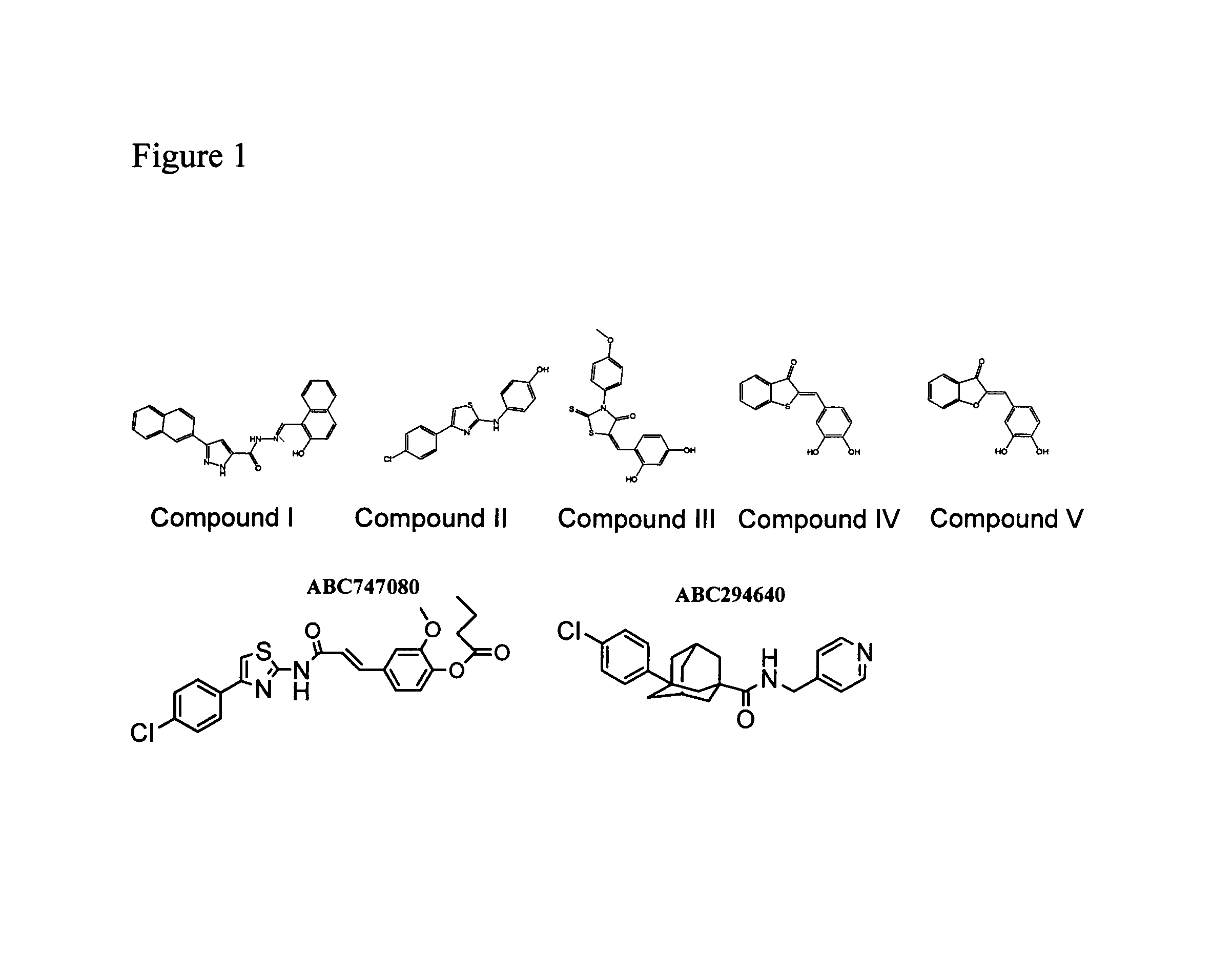Methods for the treatment and prevention of inflammatory diseases
a technology for inflammatory diseases and methods, applied in the field of methods, can solve the problems of chronic pain, acute cardiac or cerebral ischemia, and the mechanism by which this occurs not fully elucidated, and achieve the effect of inhibiting the activity of human sphingosine kinas
- Summary
- Abstract
- Description
- Claims
- Application Information
AI Technical Summary
Benefits of technology
Problems solved by technology
Method used
Image
Examples
example 1
Identification of SK Inhibitors
[0060]An assay for screening for inhibitors of SK has been established (French et al., Cancer Res 63: 5962 (2003)). A chemical library totaling approximately 16,000 compounds was screened for inhibition of SK. Representative active compounds from four chemotypes of SK inhibitors, designated herein as Compounds I-IV, are shown in FIG. 1. The compounds ABC747080 and ABC294640 (FIG. 1) also inhibit SK.
example 2
Inhibition of Endogenous SK Activity by SK Inhibitors
[0061]A cell-based assay in which the phosphorylation of exogenously added [3H]sphingosine to [3H]S1P by endogenous SK can be quantified (French et al., Cancer Res 63: 5962 (2003)) was used to evaluate the effects of test compounds on the activity of SK in intact cells. In this assay, cells are incubated with [3H]sphingosine for an appropriate period of time, and then [3H]sphingosine and [3H]S1P (formed by endogenous SK activity) are separated by extraction and levels of both species are determined by scintillation counting. We have used a number of cell lines in this assay to confirm that the SK inhibitors are active in multiple intact cell systems. For example, human umbilical vein endothelial cells (HUVECs) are commonly used as a model of human vasculature. Additionally, rat IEC6 cells are commonly used as a model of intestinal epithelial cells. As demonstrated in FIG. 2, the SK inhibitors reduce cellular levels of S1P synthesi...
example 3
Inhibition of TNFα-Induction of NFκB by SK Inhibitors
[0065]The excellent aqueous solubility of ABC294640 allowed it to be evaluated in an NFκB reporter cell line (FIG. 4). Fibroblasts transfected with an NFκB response element linked to luciferase produce high levels of luciferase upon exposure to TNFα. Activation of NFκB by TNFα was dose-dependently suppressed by the SK inhibitor, ABC294640.
PUM
| Property | Measurement | Unit |
|---|---|---|
| time | aaaaa | aaaaa |
| oxidative stress | aaaaa | aaaaa |
| concentrations | aaaaa | aaaaa |
Abstract
Description
Claims
Application Information
 Login to View More
Login to View More - R&D
- Intellectual Property
- Life Sciences
- Materials
- Tech Scout
- Unparalleled Data Quality
- Higher Quality Content
- 60% Fewer Hallucinations
Browse by: Latest US Patents, China's latest patents, Technical Efficacy Thesaurus, Application Domain, Technology Topic, Popular Technical Reports.
© 2025 PatSnap. All rights reserved.Legal|Privacy policy|Modern Slavery Act Transparency Statement|Sitemap|About US| Contact US: help@patsnap.com



